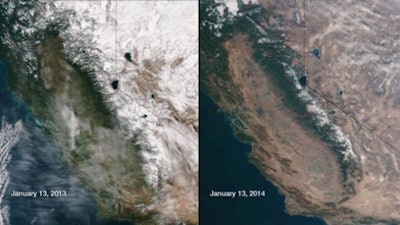
California is currently experiencing the most severe drought conditions in 500 years according to some sources, and certainly the worst in our lifetimes. How bad is it?
As we enter the fourth straight year of below-normal precipitation, reservoirs and aquifers across the state are at record lows, and the all-important snow pack in the Sierras is currently non-existent. Last year marked the driest year since 1840 and so far, 2014 has seen close to zero precipitation statewide.
For a state whose history is largely defined by the politics of water, California is facing an unprecedented crisis. And amazingly, it only looks to get worse as all weather models point to sustained dry weather.
The implications for the pool and spa industry’s largest regional market are potentially catastrophic. When we’ve faced droughts in the past, pools are one of the first things hit with draconian water rationing measures, including complete bans on filling pools, whether new or for repair purposes.
In areas where those measures go into effect, the industry is essentially shut down. No one buys or repairs pools and the economic impact is devastating. And now, with our industry only recently recovering from the mother of all recessions we just experienced, the timing couldn’t be worse.
The reasoning behind such moratoriums is both obvious and tragically false. In addition to being seen as a luxury item, pools are considered water wasters by many. It’s a perception that is hard to shake, even though it’s been proven time and time again that pools use less water per square foot than lawns.
And no one cares to acknowledge that pools are reservoirs that can be used to fight fires, which naturally increase in frequency and ferocity during droughts.
If I sound alarmed, it’s for good reason. I’ve been through this before, particularly in the mid-70s and early ’90s when we experienced severe drought conditions — none of which were as bad as this.
As was the case then, the only organization standing between our industry and the devastating impact of mandatory rationing measures is the California Pool & Spa Association (formerly known as SPEC). This organization has a long track record of successful lobbying efforts, particularly on the state government level. CPSA President John Norwood is, in my opinion, a wonderfully talented lobbyist — if there’s anyone up to the task of pushing back against wrongheaded rationing measures, it’s John.
But CPSA needs our help, which is why I’m openly asking you to join CPSA or make a donation so they can sustain their efforts during what looks to be a long and hard fight to essentially save our industry in the Golden State.
If you’re wondering what can be done to push back against rationing measures, let me share some ideas I received recently from Craig Sears, president of Sears Pool Management in Sandy Springs, Ga. Sears is a member of the local APSP chapter and was heavily involved in fighting pool filling moratoriums during the severe drought that hit the Southeast a few years ago. I was extremely impressed with the list of measures he offered.
- Change the perception that pools are water wasters. Operated correctly, pools conserve water in a clean and useful state. Pools can be tapped as emergency sources of water, especially when fighting fires — but only if they are maintained.
- Unmaintained bodies of water quickly become health hazards, breeding bacteria and disease-carrying mosquitos. Contact your state health department and ask them to issue a statement to this effect.
- Find lawmakers with a stake in the issue, such as those with pools and spas who enjoy swimming or whose kids participate in aquatic sports. Ask them to help.
- Contact local news agencies to help get word out of the importance of swimming pools in learn-to-swim programs and the fight against childhood obesity. It helps to hire a PR expert to get media exposure.
- When you do get media exposure, control the message. Make sure you and your association members are on target, and don’t go rambling on about something that’s going to distract from or implode your message. Give the media specific people to contact for comment, and make sure those people are ready to give their story.
- Contact aquatic sports organizations like USA Swimming, USA Diving, US Water Polo and Synchronized Swimming Associations, as well as the American Swimming Coaches Association. Such groups have grassroots manpower and common interests. Members of the ASCA in particular can mobilize a vast group of people, from athletes and their parents to college and Olympic training programs.
- Take a proactive approach by coming up with water conservation tips for pool owners from the industry/APSP. The industry should demonstrate that it cares and wants to help, not that we’re just being selfish and protecting our own interests. (I have a sample I can send upon request.)
- Support lobbying efforts and organizations.
- Pass the hat. Ask the industry and vested parties to chip in to help cover the costs of implementing these strategies. At the time, we didn’t have a fund for this sort of thing. Going forward, we should maintain a government relations fund and consistently ask for donations to this fund so that we’re ready the next time an issue comes along.
Much thanks to Sears for this litany of potent suggestions.
My hope is that if we band together with the CPSA and aggressively implement these measures, the California industry will weather this crisis.
Otherwise, we may wither instead.











































